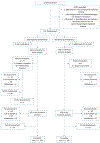Neurodevelopmental outcome at 5 years of age after general anaesthesia or awake-regional anaesthesia in infancy (GAS): an international, multicentre, randomised, controlled equivalence trial
- PMID: 30782342
- PMCID: PMC6500739
- DOI: 10.1016/S0140-6736(18)32485-1
Neurodevelopmental outcome at 5 years of age after general anaesthesia or awake-regional anaesthesia in infancy (GAS): an international, multicentre, randomised, controlled equivalence trial
Erratum in
-
Department of Error.Lancet. 2019 Aug 24;394(10199):638. doi: 10.1016/S0140-6736(19)31958-0. Lancet. 2019. PMID: 31448737 No abstract available.
Abstract
Background: In laboratory animals, exposure to most general anaesthetics leads to neurotoxicity manifested by neuronal cell death and abnormal behaviour and cognition. Some large human cohort studies have shown an association between general anaesthesia at a young age and subsequent neurodevelopmental deficits, but these studies are prone to bias. Others have found no evidence for an association. We aimed to establish whether general anaesthesia in early infancy affects neurodevelopmental outcomes.
Methods: In this international, assessor-masked, equivalence, randomised, controlled trial conducted at 28 hospitals in Australia, Italy, the USA, the UK, Canada, the Netherlands, and New Zealand, we recruited infants of less than 60 weeks' postmenstrual age who were born at more than 26 weeks' gestation and were undergoing inguinal herniorrhaphy, without previous exposure to general anaesthesia or risk factors for neurological injury. Patients were randomly assigned (1:1) by use of a web-based randomisation service to receive either awake-regional anaesthetic or sevoflurane-based general anaesthetic. Anaesthetists were aware of group allocation, but individuals administering the neurodevelopmental assessments were not. Parents were informed of their infants group allocation upon request, but were told to mask this information from assessors. The primary outcome measure was full-scale intelligence quotient (FSIQ) on the Wechsler Preschool and Primary Scale of Intelligence, third edition (WPPSI-III), at 5 years of age. The primary analysis was done on a per-protocol basis, adjusted for gestational age at birth and country, with multiple imputation used to account for missing data. An intention-to-treat analysis was also done. A difference in means of 5 points was predefined as the clinical equivalence margin. This completed trial is registered with ANZCTR, number ACTRN12606000441516, and ClinicalTrials.gov, number NCT00756600.
Findings: Between Feb 9, 2007, and Jan 31, 2013, 4023 infants were screened and 722 were randomly allocated: 363 (50%) to the awake-regional anaesthesia group and 359 (50%) to the general anaesthesia group. There were 74 protocol violations in the awake-regional anaesthesia group and two in the general anaesthesia group. Primary outcome data for the per-protocol analysis were obtained from 205 children in the awake-regional anaesthesia group and 242 in the general anaesthesia group. The median duration of general anaesthesia was 54 min (IQR 41-70). The mean FSIQ score was 99·08 (SD 18·35) in the awake-regional anaesthesia group and 98·97 (19·66) in the general anaesthesia group, with a difference in means (awake-regional anaesthesia minus general anaesthesia) of 0·23 (95% CI -2·59 to 3·06), providing strong evidence of equivalence. The results of the intention-to-treat analysis were similar to those of the per-protocol analysis.
Interpretation: Slightly less than 1 h of general anaesthesia in early infancy does not alter neurodevelopmental outcome at age 5 years compared with awake-regional anaesthesia in a predominantly male study population.
Funding: US National Institutes of Health, US Food and Drug Administration, Thrasher Research Fund, Australian National Health and Medical Research Council, Health Technologies Assessment-National Institute for Health Research (UK), Australian and New Zealand College of Anaesthetists, Murdoch Children's Research Institute, Canadian Institutes of Health Research, Canadian Anesthesiologists Society, Pfizer Canada, Italian Ministry of Health, Fonds NutsOhra, UK Clinical Research Network, Perth Children's Hospital Foundation, the Stan Perron Charitable Trust, and the Callahan Estate.
Copyright © 2019 Elsevier Ltd. All rights reserved.
Comment in
-
Neurodevelopment after general anaesthesia in infants.Lancet. 2019 Feb 16;393(10172):614-615. doi: 10.1016/S0140-6736(18)32985-4. Epub 2019 Feb 14. Lancet. 2019. PMID: 30782331 No abstract available.
-
Neurodevelopmental outcome at 5 years of age after general anaesthesia or awake-regional anaesthesia in infancy (GAS): An international, multicentre, randomised, controlled equivalence trial.Acta Paediatr. 2019 Nov;108(11):2115-2116. doi: 10.1111/apa.14943. Epub 2019 Aug 16. Acta Paediatr. 2019. PMID: 31418482 No abstract available.
References
-
- Vutskits L, Davidson A. Update on developmental anesthesia neurotoxicity. Curr Opin Anaesthesiol 2017; 30: 337–342. - PubMed
-
- Vutskits L, Xie Z. Lasting impact of general anaesthesia on the brain: mechanisms and relevance. Nat Rev Neurosci 2016; 17: 705–717. - PubMed
-
- Istaphanous GK, Ward CG, Nan X, et al. Characterization and quantification of isoflurane-induced developmental apoptotic cell death in mouse cerebral cortex. Anesth Analg 2013; 116: 845–54. - PubMed
Publication types
MeSH terms
Associated data
Grants and funding
LinkOut - more resources
Full Text Sources
Other Literature Sources
Medical


